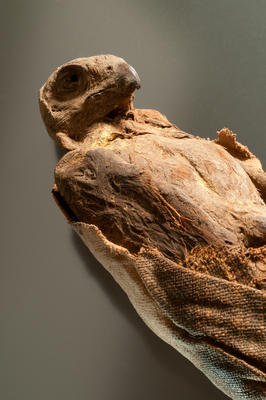Mummified animal, Falcon, Ancient Egypt
Production date
747 BCE-30 BCE
Country
Egypt
See full details
Object detail
Description
Mummified Hawk, brown coloured feathers and skin, lower half wrapped in linen cloth, wings folded to the side of the bird. Remnant gold leaf visible on the thorax.
Classification
ARCHAEOLOGY Egyptian mummified hawk
Production date
747 BCE-30 BCE
Production place
Measurements
H250mm x W80mm x D45mm
Media/Materials description
Bone (Animal Remains)
Common or European kestrel (Falco tinnunculus)
Sparrowhawk (Accipoter nisus)
Feathers (Animal Remains)
Linen (cloth)
Skin (Animal Remains)
Common or European kestrel (Falco tinnunculus)
Sparrowhawk (Accipoter nisus)
Feathers (Animal Remains)
Linen (cloth)
Skin (Animal Remains)
History and use
In ancient Egypt, a wide variety of animals were mummified, ranging from mice to bulls and even large scarab beetles. Cats, dogs, snakes, baboons and birds were the most popular mummified animals, usually bought as offerings to particular gods. Hence, a cat may be offered to Bastet, and Ibis to Thoth, or a falcon to Horus.
This mummified falcon is thought to date to the Late Period (664-305BC) or Ptolemaic Period (305-30 BC). It presents a mystery as the linen wrappings have been cut away on the thorax, and small pieces of gold leaf applied to the bird's neck and chest. It is possible this gold leaf was added in more recent times, to enhance collector value.
This mummified falcon is thought to date to the Late Period (664-305BC) or Ptolemaic Period (305-30 BC). It presents a mystery as the linen wrappings have been cut away on the thorax, and small pieces of gold leaf applied to the bird's neck and chest. It is possible this gold leaf was added in more recent times, to enhance collector value.
Associated person
Registration number
H23503



